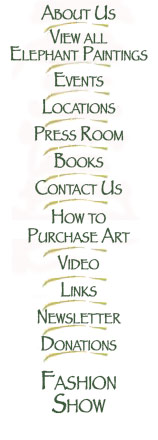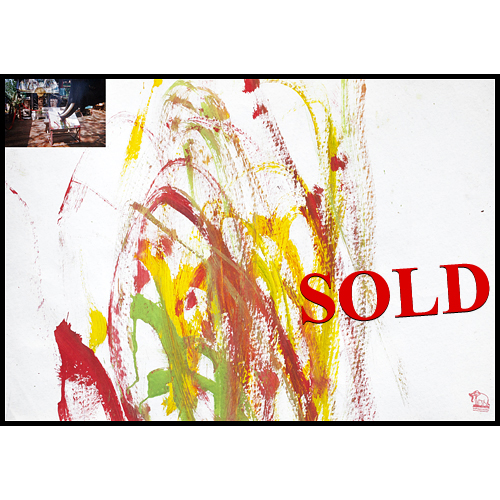Elephant Painting in Thailand
By Mia Fineman
Mia Fineman is a writer and curator in New York City. She is the author, with Vitaly Komar and Alex Melamid, of When Elephants Paint, The Quest of Two Russian Artists to Save the Elephants of Thailand.
 The
morning of her first art class, Sao, a 35-year-old female Asian elephant,
picks up a paintbrush with the tip of her trunk and tentatively places
it in her mouth. Crouching at her feet, Theung, her mahout (trainer),
gently guides her trunk back toward a blank sheet of paper laid out on
the ground. "Euughhaa, euughhaa," he says, by way of encouragement.
Sao swishes her tail, flaps her ears, and casually tosses the paintbrush
to the ground. "Gep! gep!" ("Pick it up!"), Theung
commands. Sao stretches out her trunk to retrieve the brush, and delicately
touches it to the paper at her feet. She hesitates for a moment, as her
breath rushes out the end of her trunk with a soft whooshing sound. Then,
holding her trunk straight, she takes a tiny step backward, slowly dragging
the paint-loaded brush across the surface of the paper and leaving behind
a brilliant streak of cobalt blue. "Geng mark!" ("Well
done!"), Theung says, smiling with satisfaction at what can only
be described as a moment of artistic breakthrough. For the next several
hours, Sao and Theung turn out one masterpiece after another in a focused
frenzy of interspecies collaboration.
The
morning of her first art class, Sao, a 35-year-old female Asian elephant,
picks up a paintbrush with the tip of her trunk and tentatively places
it in her mouth. Crouching at her feet, Theung, her mahout (trainer),
gently guides her trunk back toward a blank sheet of paper laid out on
the ground. "Euughhaa, euughhaa," he says, by way of encouragement.
Sao swishes her tail, flaps her ears, and casually tosses the paintbrush
to the ground. "Gep! gep!" ("Pick it up!"), Theung
commands. Sao stretches out her trunk to retrieve the brush, and delicately
touches it to the paper at her feet. She hesitates for a moment, as her
breath rushes out the end of her trunk with a soft whooshing sound. Then,
holding her trunk straight, she takes a tiny step backward, slowly dragging
the paint-loaded brush across the surface of the paper and leaving behind
a brilliant streak of cobalt blue. "Geng mark!" ("Well
done!"), Theung says, smiling with satisfaction at what can only
be described as a moment of artistic breakthrough. For the next several
hours, Sao and Theung turn out one masterpiece after another in a focused
frenzy of interspecies collaboration.
 Standing
8'6" at the shoulder with the endless legs of a supermodel, Sao is
stately, regal, and supremely self-possessed. Like most of Thailand's
3,000 domesticated elephants, she was formerly employed in the timber
industry, hauling teak logs out of the rain forests. Since the late eighties,
however, deforestation and anti-logging laws have left Sao and many other
domesticated elephants both homeless and jobless. In order to ensure their
survival, Thai elephants and their mahouts desperately need to develop
a new skills that will be marketable in a global economy.
Standing
8'6" at the shoulder with the endless legs of a supermodel, Sao is
stately, regal, and supremely self-possessed. Like most of Thailand's
3,000 domesticated elephants, she was formerly employed in the timber
industry, hauling teak logs out of the rain forests. Since the late eighties,
however, deforestation and anti-logging laws have left Sao and many other
domesticated elephants both homeless and jobless. In order to ensure their
survival, Thai elephants and their mahouts desperately need to develop
a new skills that will be marketable in a global economy.
 Fortunately,
as we discovered on our recent trip to Thailand, many of these elephants
and mahouts are endowed with tremendous reserves of untapped artistic
talent. Elephants, particularly Asian elephants (Elephas maximus), seem
to possess an innate impulse to draw. Unprompted, an Asian elephant in
captivity will often pick up a pebble or stick with the tip of her trunk
and casually doodle on the floor of her enclosure. Of course, the leap
from doodling in the sand to painting on canvas requires training, encouragement,
and art supplies-for both elephant and human artists. We were thrilled
to find that Thai elephants, conditioned by years of close collaborative
work with their mahouts, were exceptionally quick learners. Not only did
they swiftly master the fundamental techniques of painting, they also
began to develop distinctive sensibilities and styles.
Fortunately,
as we discovered on our recent trip to Thailand, many of these elephants
and mahouts are endowed with tremendous reserves of untapped artistic
talent. Elephants, particularly Asian elephants (Elephas maximus), seem
to possess an innate impulse to draw. Unprompted, an Asian elephant in
captivity will often pick up a pebble or stick with the tip of her trunk
and casually doodle on the floor of her enclosure. Of course, the leap
from doodling in the sand to painting on canvas requires training, encouragement,
and art supplies-for both elephant and human artists. We were thrilled
to find that Thai elephants, conditioned by years of close collaborative
work with their mahouts, were exceptionally quick learners. Not only did
they swiftly master the fundamental techniques of painting, they also
began to develop distinctive sensibilities and styles.
 As
painters, elephants are masters of the rapidly executed, spontaneous gesture.
With the exception of 35-year-old Sao, most of the elephant artists we
met during our travels through Thailand were relatively young, ranging
from about four- to ten-years-old. Much of their work has a youthful,
exuberant quality-a pleasure in the viscosity of the paint and a process-oriented
sense of exploration into the endless possibilities of mark-making.
As
painters, elephants are masters of the rapidly executed, spontaneous gesture.
With the exception of 35-year-old Sao, most of the elephant artists we
met during our travels through Thailand were relatively young, ranging
from about four- to ten-years-old. Much of their work has a youthful,
exuberant quality-a pleasure in the viscosity of the paint and a process-oriented
sense of exploration into the endless possibilities of mark-making.
 During the learning stage, the mahouts generally select the colors and
determine when a painting is finished. They teach the elephants how to
hold the brush, and a number of mahouts have also customized their paintbrushes,
adding bamboo handles that are easier for the elephants to grip.
During the learning stage, the mahouts generally select the colors and
determine when a painting is finished. They teach the elephants how to
hold the brush, and a number of mahouts have also customized their paintbrushes,
adding bamboo handles that are easier for the elephants to grip.
Although no two elephant paintings are alike, we discovered a number of formal similarities that suggest the emergence of three major regional styles.
 Elephant
painting of the northern, or Lampang school tends to be lyrical and expressive,
characterized by broken brushwork, curvilinear forms, and bold, clear,
primary colors. In the central Thai, or Ayutthaya school, elephants and
mahouts prefer darker, cooler colors such as deep violet, black, and forest
green, which they apply with broad, vigorous brushstrokes that sweep across
the canvas from edge to edge. Elephants of the southern, or Phuket school
tend toward saturated tertiary colors like mustard, plum, and magenta,
mixed on the surface of the paper with broad, gentle, curvy brushstrokes.
Elephant
painting of the northern, or Lampang school tends to be lyrical and expressive,
characterized by broken brushwork, curvilinear forms, and bold, clear,
primary colors. In the central Thai, or Ayutthaya school, elephants and
mahouts prefer darker, cooler colors such as deep violet, black, and forest
green, which they apply with broad, vigorous brushstrokes that sweep across
the canvas from edge to edge. Elephants of the southern, or Phuket school
tend toward saturated tertiary colors like mustard, plum, and magenta,
mixed on the surface of the paper with broad, gentle, curvy brushstrokes.
 At
this point, both the elephants and their mahouts approach the blank canvas
with an innocent eye. The canon of elephant art is still in its embryonic
stages--there are no firm guidelines and few preconceptions as to what
an elephant painting is supposed to look like. Moreover, very few elephants
or mahouts have ever set foot inside an art museum and, at least for the
moment, most remain art-world outsiders. Indeed, elephant painting is
the ultimate Outsider Art, reinvigorating a moribund art scene and resolving
the fin-de-si cle "crisis in painting" with a bold and uninhibited
return to gestural abstraction.
At
this point, both the elephants and their mahouts approach the blank canvas
with an innocent eye. The canon of elephant art is still in its embryonic
stages--there are no firm guidelines and few preconceptions as to what
an elephant painting is supposed to look like. Moreover, very few elephants
or mahouts have ever set foot inside an art museum and, at least for the
moment, most remain art-world outsiders. Indeed, elephant painting is
the ultimate Outsider Art, reinvigorating a moribund art scene and resolving
the fin-de-si cle "crisis in painting" with a bold and uninhibited
return to gestural abstraction.
 But the "innocent eye stage" of elephant painting won't last
long. With more extensive training and increased exposure, elephant artists
are bound to venture into new aesthetic territory. In order to encourage
the progress of elephant art--and of individual elephant artists--we are
now establishing several regional elephant art academies throughout Thailand.
At these academies, elephants and their handlers will be taught basic
painting techniques using non-toxic art supplies, and they will be encouraged
to develop and explore their own artistic visions. The Asian Elephant
Art and Conservation Project will also provide crucial exposure for these
budding elephant artists by showcasing their work in exhibitions worldwide.
But the "innocent eye stage" of elephant painting won't last
long. With more extensive training and increased exposure, elephant artists
are bound to venture into new aesthetic territory. In order to encourage
the progress of elephant art--and of individual elephant artists--we are
now establishing several regional elephant art academies throughout Thailand.
At these academies, elephants and their handlers will be taught basic
painting techniques using non-toxic art supplies, and they will be encouraged
to develop and explore their own artistic visions. The Asian Elephant
Art and Conservation Project will also provide crucial exposure for these
budding elephant artists by showcasing their work in exhibitions worldwide.
Elephant Abstraction may only be the first phase in the stylistic evolution of pachyderm painting. Perhaps some day soon we might see the development of Elephant Impressionism, Elephant Surrealism, even Elephant Conceptual Art. The future belongs to them.



